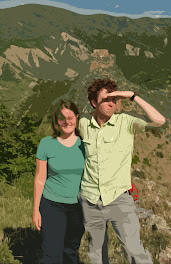Nervously scanning the street, and tilting an ear towards the darkness, we wait for a sign. They must be moving the gear soon. It’s been months since Martha and I have seen a fresh shipment arrive, and users and suppliers alike are getting restless. I just don’t know how much longer we’ll last. Martha’s already started experimenting with alternatives, but they just don’t cut it. We need fresh cheese.
Let me tell you a little about the commodity we’re discussing. When it comes to traditional Georgian cheese, at least in our region of Imereti, there’s one type, and one type only. Any variety is accidental, due to quality of milk and its freshness. Let me issue a diplomatic disclaimer by mentioning that there is nothing wrong with only one style of cheese. This uniformity does, however, force a gourmand to search for those small variations in taste and texture which set apart an average batch of Georgian cheese from that which is simply delicious.
Martha and I have had them all. Cheese that is so fresh, you have trouble calling it ‘cheese’, and would rather call it ‘viscous curds.’ We’ve also had cheese so old, it approaches something closer to a pecorino romano in its dense, dry saltiness. (Supposedly, this second variety is specially aged, and is worth twice as much as the regular stuff you find in the bazaars. Where and in what conditions it spends it’s ageing process developing its special funk, I’d rather not imagine.)
This might seem as though we are betraying our Peace Corps heartiness by delving into cheese snobbery, but we are merely doing our part in our cultural assimilation into the Georgian cheesescape. You see, Georgians take cheese very seriously. Though this may not be apparent at first – you begin to pick up the signs after a while. In Sakartvelo, it’s all about who you know.
A few months ago, our host mother Zoia nonchalantly brought in a black cellophane baggie filled with what could only be described as “the-greatest-Georgian-cheese-we’ve-ever-tasted.” It was firm, fresh, and light, with the right mix of creamy, tangy overtones and slightly dry, feta-like finish. We chewed in silence, only opening our eyes to exchange quick knowing glances which acknowledged the immensity of our find. “Zoia!” We proclaimed, “Where did you get this marvel?”1She cryptically told us that she had a woman, a neighbor, who makes it fresh, with milk from her cows.
Our mission was set. Every evening since, while our fellow volunteers scan the Georgian airwaves for news about recent Russian incursions or Eurovision song contest results, Martha and I sit on our porch, intently watching the procession of cows returning from the fields, trying to deduce which house on
We’ve tried asking around, trying to find the source. Medea, our host cousin, when asked about it, told us that she’d help us to “score some freshie.” (That’s how we speak in the cheese underworld.) She walked a few feet, and out of earshot, placed a few phone calls, only to return with the answer we didn’t want. No one had any fresh cheese. The suppliers had nothing to offer. I tried asking one of my counterparts (the one who played goalie on the Soviet national handball team), and though she also pledged to help me in my situation, did nothing, but stared me down for the rest of the break period between classes, with a look that said “the only cheese you’ll find is the one called ‘hurt’.”
Everyday, the cows go out, and then return, their swinging udders veiny and swollen, taunting Martha and I from the street with their incessant bovine bellows. The milk must be going somewhere. The cow with the Midas udder must exist. Perhaps we are not as integrated into Terjola as we thought. Perhaps we’re not using the lingo correctly. Perhaps, when I ask for names, numbers, or locations, I come off as a complete dairy rube. Perhaps – and this is my current theory – there’s a secret society which manages the allocation and production of this mysterious magical cheese, and, as foreign nationals, we’ll never be allowed in.
In my imagination, this society, this confederation of cheese-heads if you will, must meet in some pretty swanky digs to discuss their production targets. That billionaire’s garish house/airport/mini-mall on the hill in
1 (Actually, I probably said: “zoia, es pantastikuri yveli, saidan modis?” --> “Zoia, this fantastic cheese, from where it comes?)

No comments:
Post a Comment